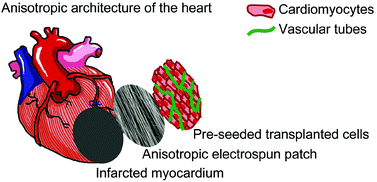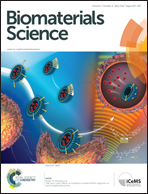A nanopatterned cell-seeded cardiac patch prevents electro-uncoupling and improves the therapeutic efficacy of cardiac repair†
Abstract
The heart is an extremely sophisticated organ with nanoscale anisotropic structure, contractility and electro-conductivity; however, few studies have addressed the influence of cardiac anisotropy on cell transplantation for myocardial repair. Here, we hypothesized that a graft's anisotropy of myofiber orientation determines the mechano-electrical characteristics and the therapeutic efficacy. We developed aligned- and random-orientated nanofibrous electrospun patches (aEP and rEP, respectively) with or without seeding of cardiomyocytes (CMs) and endothelial cells (ECs) to test this hypothesis. Atomic force microscopy showed a better beating frequency and amplitude of CMs when cultured on aEP than that from cells cultured on rEP. For the in vivo test, a total of 66 rats were divided into six groups: sham, myocardial infarction (MI), MI + aEP, MI + rEP, MI + CM–EC/aEP and MI + CM–EC/rEP (n ≥ 10 for each group). Implantation of aEP or rEP provided mechanical support and thus retarded functional aggravation at 56 days after MI. Importantly, CM–EC/aEP implantation further improved therapeutic outcomes, while cardiac deterioration occurred on the CM–EC/rEP group. Similar results were shown by hemodynamic and infarct size examination. Another independent in vivo study was performed and electrocardiography and optical mapping demonstrated that there were more ectopic activities and defective electro-coupling after CM–EC/rEP implantation, which worsened cardiac functions. Together these results provide comprehensive functional characterizations and demonstrate the therapeutic efficacy of a nanopatterned anisotropic cardiac patch. Importantly, the study confirms the significance of cardiac anisotropy recapitulation in myocardial tissue engineering, which is valuable for the future development of translational nanomedicine.


 Please wait while we load your content...
Please wait while we load your content...